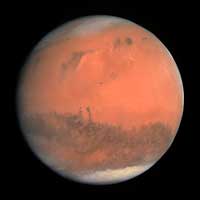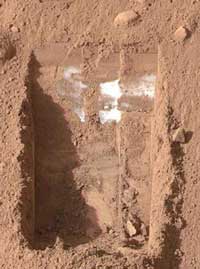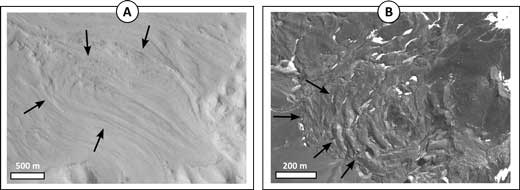Glaciers on Mars: looking for the ice Understand article
One of the scientists’ main interests in Mars research is water. Is there water on Mars?

The image was acquired in
2007 from a distance of
about 240 000 km; its
resolution is about 5
km/pixel.
Image courtesy of ESA 2007
MPS for OSIRIS Team MPS/UPD/
LAM/IAA/ RSSD/ INTA/ UPM/
DASP/ IDA
At the expected time, the orbiter, flying at about 300 km in altitude and around 3.5 km s-1, focused toward the surface of the arid, cold and reddish planet and opened the shutter of the complex and precise camera. A new image from the Martian surface, and gigabytes of data, were then recorded at the same time. This process has been repeated many times in recent decades by the different orbiters, landers and roversw1 that we have sent to our nearest planet. Every new image and data set increases the incredibly huge databasew2,w3 of information on Mars. Scientists from all around the world use these resources to study the planet’s chemical, physical, climatic and geological environment, with the aim of understanding more about Mars and how it – and even Earth – has evolved.
This widespread availability of imagesw4 and data is one of the most amazing phenomena in the history of science never before have so many experts shared so much information and produced so many models and results.
Do you know the composition of the Martian polar caps?
The northern polar cap of Mars is mainly H2O ice. However, the southern polar cap comprises H2O ice and CO2 ice.
Water and ice on Mars
One of the scientists’ main interests in Mars research is water. Is there water on Mars? Where is it? Is it liquid or frozen? In the past, were there oceans, seas, lakes and rivers on Mars? How did they disappear? Is their disappearance related to the past and present climate of the planet? But also: Is there, or was there, life on Mars? And could humans live there one day?

northern polar cap of Mars,
where water ice was
observed just a few
centimeters below the
surface.
Images courtesy of NASA/JPL
/University of Arizona
Thanks to the data acquired by orbiters, landers and roversw5, we know that Mars had liquid water millions of years ago – flowing on its surface, filling the basins of impact craters, forming lakes, flowing downslope of some volcanoes’ flanks, from the Martian highlands to the lowlands, where an extensive ocean could have existed (referred to as Oceanus Borealis).
Solid water is a different matter. Ice polar caps on Mars were identified from telescopes and clearly recognisable on orbiters’ imagesw6, and frozen soils have been confirmed in several places on the planet, mostly thanks to the images reported by NASA’s Phoenix mission at high latitudes. The low temperatures of the planet throughout the year, measured by different landers and rovers (such as Viking I and II, Mars Pathfinder, Spirit, Opportunity and Curiosity, which arrived on Mars in August 2012), confirm that ice is stable at all latitudes. In fact, the mean temperature of Mars is about -80ºC during daytime; at the Equator, the sunny slopes in the summer at noon hours can reach a surface temperature of 15 ºC.
Studying Martian glaciers
Today, research on Martian icew7 focuses on finding evidence of the presence of ice and glacial-related features using new high-resolution (as high as 35 cm/pixel) images acquired by the active missions of NASA and the European Space Agency (ESA). Our research group focused on the northwest flank of the Hecates Tholus volcano in the Elysium region of Mars, at tropical latitudes of the northern hemisphere. We analysed all the available images from different orbiters covering this region (at different spectral, temporal and spatial resolutions), and observed features that we interpreted to be caused by glacial erosion or sedimentation: moraines, crevasses, roches moutonnées, glacial cirques, hanging valleys, eskers, drumlins or arêtes, among othersw9.
Our interpretations were based on the comparison between the marsforms (the reliefs observed on Mars) and the terrestrial landforms in the Alps, Iceland or Antarctica, where we conducted fieldwork looking for terrestrial analogues. We also used the ‘multiple working hypotheses’ scientific method to discard other processes that are able to produce similar features as the origin of the marsforms we observe. Then, after months of work in front of the computerw8 and on different field trips, and thanks to the satellite images and topographic, spectrometric and thermal data, we carried out a detailed description, mapping and age determination of the features observed on the flank of the Martian volcano. Our first conclusion, based on the long list of glacial-related features on the Hecates Tholus volcano, is that an important amount of ice existed there for a long time, forming glaciers that flowed downslope, sculpting the flanks of the edifice.
Did you know that Martian volcanoes had glaciers?
Many Martian volcanoes show reliefs on their flanks that are caused by glacial ice flows – just as we see on Earth. Those volcanoes are located not at polar but at tropical latitudes. Olympus Mons, Ascraeus Mons and Hecates Tholus are examples of volcanoes with glaciers, similar to Mount Kilimanjaro (Tanzania) and Cotopaxi (Ecuador) on Earth.
Did you know that Mars had ice ages?
Crater counting has provided evidence of glacial activity, both ancient (more than 1000 million years ago) and recent (less than 2 million years ago). The cold periods in Mars history are related to orbital changes (mainly changes to spin axis angle) – just like Earth, where the orbital cycles control most of the Quaternary climate change, as discovered by Milutin Milankovic in 1922!

Images courtesy of HiRISE/UA/NASA and DigitalGlobe
The problem is… we couldn’t find ice anywhere! However, we could see some glacial features that we know can’t survive for long after ice melts. This is the case for crevasses: fractures in the glacier disappear when ice melts or sublimates. We didn’t see the ice on this part of Mars, but we could recognise the crevasses sculpted in the dust layer that covers the ice. For that reason, our second conclusion is that the ice causing the extensive fields of glacial marsforms must still be below the surface – or it melted very, very recently.
Through crater counting (see box below), we also calculated the age of the different glacial deposits that we observed on the images. We found a wide range of ages – from 1000 million years to 350 000 years – which means that the Hecates Tholus volcano had a long history in which the glaciers slowly sculpted its northwestern flank. In fact, we proposed the existence of cold periods, in which the ice tongues covered an important part of the volcano and its surroundings, and also warmer periods, in which the glaciers were smaller and covered only parts of the flank, such as in the present time.
Do you know how scientists estimate the age of the surfaces of Mars?
It is simple and efficient: they count the craters left by meteorites after their impacts on the surface of Mars – and any other planet or moon. High crater density corresponds to old surfaces and low crater density is linked to young surfaces.

Mars northern polar ice cap
section, based on ground
penetration radar data
showing the ice and
sediments layers.
Image courtesy of NASA/ESA/
JPL- Caltech/University of
Rome/Washington University
in St. Louis
Future steps
We plan to repeat our observational study in other volcanic regions on Mars to see if the same pattern exists and to get a better idea of the global distribution of glaciers and ice on Mars. These studies will further our understanding of the climate, its evolution and its characteristics on our neighbouring planet. The presence of glacial features on volcanic edifices could also mark the location of sites where life, if it existed, could have found water and heat to survive, even in the cold and dry environment on Mars.
Upcoming studies will use a new kind of tool: penetration radar. This technique allows us to measure the properties of materials below the surface and to investigate their variations: if there is ice below the surface, it should be distinguishable in the radar data, just as we observed in the Martian polar caps. Radar data from NASA and ESA will allow us to corroborate our interpretations of observations from the Hecates Tholus glaciers and other areas on the red planet, thanks to a modern, collaborative and interplanetary effort to further science.
Did you know that liquid water is not stable on Mars?
All the water that has been found on Mars exists in a gas or solid state. Mars’ atmospheric pressure is very low (around 6 mbar, compared with Earth’s average of 1013 mbar) and below the minimum required for liquid water stability.
References
- De Pablo MA, Centeno JD (2012) Geomorphological map of the lower NW flank of the Hecates Tholus volcano, Mars (scale 1:100,000). Journal of Maps 8: 208-214
Web References
- w1 – NASA’s Mars Exploration Missions website provides information on all the past, present and future missions to Mars by different countries and space agencies.
- w2 – The Planetary Science Archive of the ESA stores data from planetary and universe exploration missions. It is free to use.
- w3 – NASA’s Planetary Data System stores all the data from the planetary and universe exploration missions. It is free to use.
- w4 – The All Mars images webpage from Arizona State University (USA) shows all the images from Mars acquired since the Viking missions in the late 1970s. To investigate this user-friendly resource.
- w5 – The Mars Orbital Data Explorer has a user-friendly search tool to extract data from any mission to Mars.
- w6 – The Mars Odyssey’s THEMIS has generated many images that can be searched by topic (including ice-related topics). The site is useful for learning and develop of didactic activities.
- w7 – The website of the Mars Ice Consortium contains links to free educational resources about Mars from different institutions.
- w8 – JMars is a freeware and multiplatform Geographic Information System that is used by planetary scientists to visualise different types of data from Mars, such as images, topography, spectrometry and many other data. The site requires free registration.
- w9 – You can search for glacier-related terminology and photos on the Glaciers online photo glossary for secondary education.
Resources
- The Google Earth freeware allows viewers to visualise images at different resolutions and scales not only of Earth but also of Mars (and the Moon). and can be used to make comparative analysis.
- The Google Mars webpage contains a simple map of Mars with topography, and mosaics of visible and infrared images.
- To learn more about the history and evolution of Mars, see:
- Forget C, Costard F, Lognonné P (2006) Planet Mars: story of another world. Chichester, UK: Springer-Verlag/Praxis. ISBN: 978-0387489254
- Ever thought of visiting Mars? This book might give you all the good tips to do so:
- Hartmann WK (2003) A travelers’ guide to Mars. USA:Workman Publishing Company. ISBN: 978-0761126065
- To learn more about the story of water on Mars, see:
- Carr MH (1996) The water on Mars. Oxford, UK: Oxford University Press. ISBN: 978-0195099386
- To lean more about the geology of Mars, see:
- Carr MH (2006) The surface of Mars. Cambridge, UK: Cambridge University Press. ISBN: 978-0521872010
- To learn more about the evolution of the climate on Mars, and how it was once wet and warm, read:
- Kargel JS (2004) Mars: a warmer and wetter planet. Chichester, UK:Springer-Verlag/Praxis. ISBN: 978-1852335687
Review
The article is interesting because the teachers and students can understand that currently research can be done if you spend many hours in search of free international databases, if you compare many images and of course if you have expertise in a scientific field. Then you can emit a theory which has to be proved by another research and so on. The supplementary links and educational resources can be the starting point for inquiry based learning projects with the title like these: Earth and Mars Similarities, Studying the Mars Planet or Life on Mars.
Corina Lavinia Toma, Computer Science High School “Tiberiu Popoviciu” Cluj Napoca, Romania





